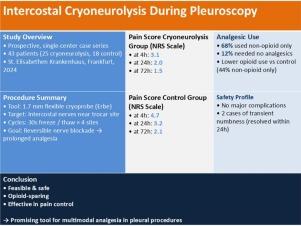Feasibility and Safety of Intercostal Cryoneurolysis During Pleuroscopy: A Novel Analgesic Approach Using a 1.7 mm Cryoprobe
Q4 Medicine
引用次数: 0
Abstract
Introduction
Pleuroscopy is a minimally invasive and highly effective procedure used for diagnosing pleural diseases. Despite its utility, pain during and after the procedure can be significant. Traditional analgesic approaches, including systemic opioids and local anaesthetics albeit potent, may provide incomplete pain relief and can be associated with side effects. Cryoneurolysis has emerged as a feasible analgesic technique in general surgery. However, an equivalent treatment modality has yet to be established for pleuroscopy.
Objectives
To investigate the safety and feasibility of cryoneurolysis in pleuroscopy performed using a 1.7 mm cryoprobe via a semi-rigid pleuroscope.
Materials and methods
We conducted a prospective, single-centre observational study on 43 patients who underwent pleuroscopy at our institution between January 2024 and December 2024, of which 25 received cryoneurolysis. Pain levels were assessed using a Numeric Rating Scale (NRS) immediately post-procedure and at 24 and 72 h. Complications and long-term adverse events were documented.
Results
NRS scores after cryoneurolysis showed successful pain management both immediately post-procedure (mean NRS: 3.1) and at subsequent time points (24 h: 2.0; 72 h: 1.5). No major complications, such as major haemorrhage or nerve injury leading to persistent deficits, were observed. Minor complications occurred in 2 patients, who experienced a transient numbness immediately post-procedure. Analgesic requirements were lower than the control group, with 68% of patients requiring only mild oral analgesics post-procedurally.
Conclusion
The use of cryoneurolysis during pleuroscopy appears to be a feasible, safe, and effective technique for pain management. However, further studies with larger cohorts are warranted to validate the findings.

胸膜镜下肋间冷冻松解术的可行性和安全性:一种使用1.7 mm冷冻探针的新型镇痛方法
胸膜镜检查是一种微创、高效的胸膜疾病诊断方法。尽管它很实用,但手术期间和手术后的疼痛可能很严重。传统的镇痛方法,包括全身阿片类药物和局部麻醉,虽然有效,但可能提供不完全的疼痛缓解,并可能伴有副作用。在普通外科中,冷冻神经溶解已成为一种可行的镇痛技术。然而,胸膜镜检查的等效治疗方式尚未建立。目的探讨在半刚性胸腔镜下使用1.7 mm冷冻探针进行胸腔镜下冷冻神经溶解的安全性和可行性。材料和方法我们对2024年1月至2024年12月在我院接受胸膜镜检查的43例患者进行了一项前瞻性、单中心观察性研究,其中25例接受了冷冻神经溶解。术后即刻、24小时和72小时采用数字评定量表(NRS)评估疼痛水平。记录并发症和长期不良事件。结果冷冻松解术后snrs评分显示手术后立即(平均NRS: 3.1)和随后时间点(24小时:2.0;72小时:1.5)。没有观察到重大并发症,如大出血或神经损伤导致持续缺陷。2例患者出现轻微并发症,术后立即出现一过性麻木。镇痛药需求低于对照组,68%的患者术后仅需要轻度口服镇痛药。结论胸膜镜下冷冻神经溶解术是治疗疼痛的一种可行、安全、有效的方法。然而,需要更大规模的进一步研究来验证这些发现。
本文章由计算机程序翻译,如有差异,请以英文原文为准。
求助全文
约1分钟内获得全文
求助全文
来源期刊

Open Respiratory Archives
Medicine-Pulmonary and Respiratory Medicine
CiteScore
1.10
自引率
0.00%
发文量
58
审稿时长
51 days
 求助内容:
求助内容: 应助结果提醒方式:
应助结果提醒方式:


